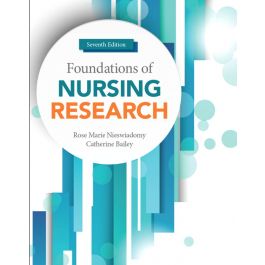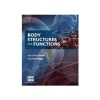Test Bank for Foundations of Nursing Research 7th Edition by Nieswiadomy
$55.00 Original price was: $55.00.$29.99Current price is: $29.99.
Test Bank for Foundations of Nursing Research 7th Edition by Nieswiadomy
This is completed downloadable of Test Bank for Foundations of Nursing Research 7th Edition by Nieswiadomy

Product Details:
- ISBN-10 : 9780134167213
- ISBN-13 : 978-0134167213
- Author: Nieswiadomy
For use as a primary text in undergraduate nursing research courses.Clear, engaging writing sparks an interest in nursing research and evidence-based nursing
Foundations of Nursing Research illuminates all steps of the nursing research process, helping readers understand the importance of research to evidence-based nursing practice, evaluate and critique research, and determine whether study findings are ready to apply in practice. Its conversational tone explains research simply and clearly. To illustrate specific aspects of the research process, extensive research study excerpts are interspersed throughout the book, including research performed outside the U.S. User-friendly learning features include chapter objectives, key terms, summaries, review questions, research links, and self-tests.
Also available packaged with MyLabTM Nursing or via Pearson eText.
Table of Content:
- Part I Introduction to Nursing Research
- Chapter 1 Development of Nursing Research
- Objectives
- Importance of Research to Nursing
- Definitions of Nursing Research
- Sources of Nursing Knowledge
- Scientific Research
- Purposes of Nursing Research
- Funding of Nursing Research
- Goals for Conducting Nursing Research
- Promote Evidence-Based Nursing Practice
- Ensure Credibility of the Nursing Profession
- Provide Accountability for Nursing Practice
- Document the Cost-Effectiveness of Nursing Care
- Quantitative and Qualitative Research
- Nurses and Research
- Roles of Nurses in Research
- History of Nursing Research
- National Institute of Nursing Research
- The Cochrane Collaboration and the Cochrane Nursing Care Field
- Research Priorities into the Future
- National Association of Orthopaedic Nurses
- Mental Health Nursing
- Oncology Nursing Society
- Institute of Emergency Nursing Research
- Association of Community Health Nurse Educators
- Research in Nursing Education
- Future Strategies for Improved Healthcare Quality
- Summary
- Self-Test
- References
- Chapter 2 Evidence-Based Nursing Practice
- Objectives
- Defining Evidence-Based Practice
- Why we use evidence-based practice
- Research Utilization versus Evidence-Based Practice
- Evidence-Based Nursing Practice
- Benefits of EBP
- Asking Clinical Questions
- Sources for Evidence for Practice
- The Cochrane Collaboration
- The Cochrane Library
- Cochrane Database
- Cochrane Centers
- Cochrane Nursing Care Field
- Agency for Healthcare Research and Quality
- Evidence-Based Practice Centers
- U.S. Preventive Services Task Force
- National Guideline Clearinghouse
- National Quality Forum
- Evidence-Based Nursing Practice Centers
- Joanna Briggs Institute
- ACE Center for Advancing Clinical Excellence
- Sarah Cole Hirsh Institute
- Summary
- Self-Test
- References
- Chapter 3 Research Evidence in Nursing Practice
- Objectives
- The Evolving Nature of Evidence-Based Practice
- Models to Promote Evidence-Based Practice in Nursing
- The Stetler Model
- The Iowa Model
- Discussion of Iowa Model Concepts
- Leadership Responsibilities
- Evaluation
- Application
- Implementation
- Barriers Associated with EBP
- Facilitators of Evidence-Based Practice
- Application of the Iowa Model
- Summary
- Self-Test
- References
- Chapter 4 Ethical Issues in Nursing Research
- Objectives
- Development of Ethical Codes and Guidelines
- Historical Overview
- Unethical Research in the United States
- Ethical Research Guidelines
- Founding Principles of Ethical Research
- Institutional Review Boards
- Members of Institutional Review Boards
- IRB Review
- Elements of Informed Consent
- Description of Purpose of Study and Study Procedures
- Description of Unforeseeable Risks
- Description of Benefits
- Disclosure of Appropriate Alternative Procedures
- Description of Maintenance of Confidentiality or Anonymity
- Plans for Unforeseeable Injuries
- Contact Information for Questions Relevant to the Study
- Assurance of Freedom to Volunteer for or Withdraw from the Study
- Documentation of Informed Consent
- Integrity in Research
- Research Guidelines for Nurses
- Nurse Researcher as a Patient Advocate
- Critiquing the Ethical Aspects of a Study
- Summary
- Self-Test
- References
- Chapter 5 An Overview of Quantitative and Qualitative Research
- Objectives
- Introduction
- Comparison of Qualitative and Quantitative Research
- Steps in Quantitative Research
- Identify the Research Problem
- Determine the Purpose of the Study
- Formulate the Research Question
- Review the Literature
- Develop a Theoretical/Conceptual Framework
- Identify the Study Assumptions
- Acknowledge the Limitations of the Study
- Formulate the Hypothesis
- Define the Study Variables/Terms
- Select the Research Design
- Identify the Population
- Select the Sample
- Conduct a Pilot Study
- Collect the Data
- Organize the Data for Analysis
- Analyze the Data
- Interpret the Findings
- Communicate the Findings
- Utilize the Findings
- Qualitative Nursing Research
- Types of Qualitative Research
- Identify the Problem of the Study
- State the Purpose
- Select the Research Design
- Review the Literature
- Select the Sample
- Gain Entry to the Research Site
- Protect the Rights of Participants
- Collect the Data
- Analyze the Data
- Interpret the Data
- Communicate the Study Results
- Utilize the Study Results
- Combining Qualitative and Quantitative Methods
- Summary
- Self-Test
- References
- Part II Preliminary Steps in the Research Process
- Chapter 6 Identifying Nursing Research Problems
- Objectives
- Introduction
- Sources of Nursing Research Problems
- Personal Experiences
- Literature Sources
- Existing Theories
- Previous Research
- Research Problem Considerations
- Ethical Issues
- Significance to Nursing
- Personal Motivation
- Researcher Qualifications
- Feasibility of Study
- Time
- Cost
- Equipment and Supplies
- Administrative Support
- Peer Support
- Availability of Subjects
- Research Question Criteria
- Written in Interrogative Sentence Form
- Includes the Population
- Includes the Variable(s)
- One-Variable Studies
- Two-Variable Studies
- Multiple-Variable Studies
- Empirically Testable
- Research Question Format
- Critiquing Problem Statements, Purpose Statements, and Research Questions
- Problem Statement
- Purpose Statement
- Research Questions
- Summary
- Self-Test
- References
- Chapter 7 Review of the Literature
- Objectives
- Introduction
- Purposes of the Literature Review
- Literature Sources
- Types of Information Sources
- Primary and Secondary Sources
- Grey Literature
- Search Strategies
- Develop a Search Strategy
- Decide on your search question
- Question whether the topic needs to be more specific
- Create a set of search terms or phrases
- Decide if currency is important
- Use options and limiters
- Ask a Librarian
- Finding Tools
- Catalogs
- Databases
- Selected Databases for Nursing Students
- CINAHL Databases
- MEDLINE Databases
- Cochrane Database of Systematic Review
- Ovid Nursing database
- PsychINFO
- ProQuest Dissertations & Theses Database (PQDT)
- Science Direct
- Scopus
- Search Engines
- Writing the Literature Review
- Extracting Information from Literature Sources
- Critiquing the Literature Review in a Research Article
- Components of a Literature Review
- Summary
- Self-Test
- References
- Chapter 8 Theory and Nursing Research
- Objectives
- Introduction
- Theory Terminology
- Theory
- Concept
- Construct
- Propositional Statements
- Empirical Generalization
- Hypothesis
- Model
- Conceptual Models
- Paradigm and Metaparadigm
- Types and Scope of Theories in Nursing Research
- Paradigms and Metaparadigms
- Nursing Conceptual Models
- Orem’s Self-Care Model
- Rogers’s Science of Unitary Human Beings
- Roy’s Adaptation Model
- Neuman’s Systems Model
- Middle-range and Practice Theories
- Integrating Theory into Nursing Research
- Theories from Nursing
- Combining Two Nursing Theories
- Theories from Other Disciplines
- Combining Theories from Nursing and Other Disciplines
- Theoretical and Conceptual Frameworks
- Theoretical Development, Testing, and Critique
- Theory Generation and Development
- Theory Testing in Nursing Research
- Critiquing the Theoretical Framework of a Study
- Summary
- Self-Test
- References
- Chapter 9 Hypotheses
- Objectives
- Introduction
- Hypotheses Overview
- Purposes of Hypotheses
- Sources or Rationale for Hypotheses
- Classifications of Hypotheses
- Simple and Complex Hypotheses
- Nondirectional and Directional Research Hypotheses
- Causal and Associative Research Hypotheses
- Null and Research Hypotheses
- Developing Hypotheses
- Hypothesis Format
- Hypotheses and Theory Testing
- Critiquing Hypotheses
- Summary
- Self-Test
- References
- Part III Research Designs
- Chapter 10 Quantitative Research Designs
- Objectives
- Introduction
- Exploratory, Descriptive, and Explanatory Studies
- Research Designs
- Experimental Research
- Validity of Experimental Designs
- Threats to Internal Validity
- Selection Bias
- History
- Maturation
- Testing
- Instrumentation Change
- Mortality
- Threats to External Validity
- Hawthorne Effect
- Experimenter Effect
- Reactive Effects of the Pretest
- Symbolic Presentation of Research Designs
- Types of Experimental Designs
- True Experimental Designs
- Pretest-Posttest Control Group Design
- Posttest-Only Control Group Design
- Solomon Four-Group Design
- Quasi-Experimental Designs
- Nonequivalent Control Group Design
- Time-Series Design
- Pre-Experimental Designs
- One-Shot Case Study
- One-Group Pretest-Posttest Design
- Nonexperimental Research
- Types of Nonexperimental Designs
- Survey Studies
- Correlational Studies
- Comparative Studies
- Methodological Studies
- Secondary Analysis Studies
- Settings for Research
- Critiquing Quantitative Research Designs
- Summary
- Self-Test
- References
- Chapter 11 Qualitative and Mixed Methods Research Designs
- Objectives
- Introduction
- Qualitative Research Designs
- Phenomenology
- Ethnographic Studies
- Grounded Theory
- Narrative Inquiry
- Case Studies
- Action Research Studies
- Mixed Methods Research
- Strategies for Mixed Methods Research
- Summary
- Self-Test
- References
- Part IV Obtaining Study Participants and Collection of Data
- Chapter 12 Populations and Samples
- Objectives
- Introduction
- Populations
- Samples and Sampling
- Probability Sampling Methods
- Simple Random Sampling
- Stratified Random Sampling
- Cluster Random Sampling
- Systematic Random Sampling
- Nonprobability Sampling Methods
- Convenience Sampling
- Quota Sampling
- Purposive Sampling
- Time Frame for Studying the Sample
- Sampling Concepts and Factors
- Sample Size
- Sampling Error and Sampling Bias
- Randomization Procedures in Research
- Critiquing the Sampling Procedure
- Summary
- Self-Test
- References
- Chapter 13 Measurement and Data Collection
- Objectives
- Introduction
- Measurement
- Level of Measurement
- Converting Data to a Lower Level of Measurement
- Determining the Appropriate Level of Measurement
- Data-Collection Process
- Data-Collection Methods
- Data-Collection Instruments
- Use of Existing Instruments
- Developing an Instrument
- Pilot Studies
- Criteria for Selection of a Data-Collection Instrument
- Practicality of the Instrument
- Reliability of the Instrument
- Stability Reliability
- Equivalence Reliability
- Internal Consistency Reliability
- Validity of the Instrument
- Face Validity
- Content Validity
- Criterion Validity
- Construct Validity
- Relationship between Reliability and Validity
- Utilizing the Data
- Sources of Error in Data Collection
- Preparing Data for Analysis
- Critiquing Data-Collection Procedures
- Summary
- Self-Test
- References
- Chapter 14 Data-Collection Methods
- Objectives
- Introduction
- Questionnaires
- Overall Appearance of Questionnaire
- Language and Reading Level of Questions
- Length of Questionnaire and Questions
- Wording of Questions
- Types of Questions
- Demographic Questions
- Closed-Ended Questions
- Open-Ended Questions
- Contingency Questions
- Filler Questions
- Placement of Questions
- Cover Letter
- Completion Instructions
- Distribution of Questionnaires
- Factors Influencing Response Rates
- Advantages of Questionnaires
- Disadvantages of Questionnaires
- Interviews
- Types of Interviews
- Interview Instruments
- Interview Questions
- Interviewer Training
- Timing and Setting for Interviews
- Interviewer Guidelines
- Influence of Interviewers on Respondents
- Advantages of Interviews
- Disadvantages of Interviews
- Observation Methods
- Determining Behaviors to be Observed
- Research Observers
- Observation Procedures
- Structured and Unstructured Observations
- Event Sampling and Time Sampling
- Relationship between Observer and Subjects
- The Role of the Nurse versus the Researcher
- Attitude Scales
- Likert Scale
- Semantic Differential Scales
- Physiological and Psychological Measures
- Psychological Tests
- Personality Inventories
- Projective Technique
- Other Data-Collection Methods
- Q Sort
- Delphi Technique
- Visual Analogue Scale
- Preexisting Data
- Critiquing Data-Collection Methods
- Summary
- Self-Test
- References
- Part V Data Analysis
- Chapter 15 Descriptive Statistics
- Objectives
- Introduction
- Key Concepts in Statistics
- Statistical Symbols
- Classifications of Statistics
- Descriptive Statistics
- Measures to Condense Data
- Frequency Distributions
- Graphic Presentations
- Bar Graph
- Histogram
- Frequency Polygon
- Percentages
- Measures of Central Tendency
- Mode
- Median
- Mean
- Measures of Variability
- Range
- Percentile
- Standard Deviation
- Variance
- Z-Scores
- Measures of Relationships
- Correlation Coefficients
- Scatter Plots
- Contingency Tables
- Types of Correlational Procedures
- Pearson r
- Spearman Rho
- Correlational procedures for nominal data
- Intraocular Method of Data Analysis
- Critiquing Descriptive Statistics in Research Reports
- Summary
- Self-Test
- References
- Chapter 16 Inferential Statistics
- Objectives
- Introduction
- Purposes of Inferential Statistics
- Estimating Population Parameters
- Sampling Distribution of the Mean
- Confidence Intervals
- Testing Hypotheses
- The Study Hypothesis
- Choosing a Statistical Test
- Level of Significance
- One-Tailed and Two-Tailed Tests
- Calculating the Test Statistic
- Comparing Calculated Value and Critical Value
- Support for the Study Hypothesis
- Factors Affecting Choice of Statistical Measures
- Parametric and Nonparametric Statistical Tests
- Power of a Statistical Test
- Type I and Type II Errors
- Statistical Tests Used in Nursing Research
- t Test
- Analysis of Variance
- Chi-Square
- Testing the Significance of Correlation Coefficients
- Advanced Statistical Tests
- Critiquing Inferential Statistics in Research Reports
- Summary
- Self-Test
- References
- Chapter 17 Presentation and Discussion of Study Findings
- Objectives
- Introduction
- Presentation of Findings of the Study
- Findings of the Study
- Ethical Issues in Presenting Research Findings
- Narrative Presentation of Findings
- Tables
- Figures
- Discussion of Findings and Significance
- Discussion of Study Hypotheses
- Statistical and Clinical Significance
- Conclusions, Implications, and Recommendations
- Conclusions
- Implications
- Recommendations
- Replication of the Research Study
- Consideration of Study Limitations in Future Research
- Extensions of the Research Study
- Critiquing the Presentation of Study Findings
- Summary
- Self-Test
- References
- Part VI Research Findings and Nursing Practice
- Chapter 18 Communication and Utilization of Nursing Research
- Objectives
- Introduction
- Communication of Nursing Research Findings
- Preparing a Research Report
- Presenting Research Results at Professional Conferences
- Presenting a Research Paper
- Presenting a Research Poster
- Publishing a Journal Article
- Preparing the Article
- Selecting a Journal
- Choosing Between Refereed and Nonrefereed Journals
- Sending Query Letters
- Reasons for Manuscript Rejection
- Preparing Research Reports for Funding Agencies
- Preparing Theses and Dissertations
- Utilization of Nursing Research Findings
- Additional Barriers to Nursing Research Utilization
- Inadequate Dissemination of Research Findings
- Findings are Not Ready for Use in Practice
- Bridging the Gap between Research and Practice
- WCHEN Project
- CURN Project
- Rogers’s Innovation-Diffusion Model
- Summary
- Self-Test
- References
- Chapter 19 Nursing Research and Healthcare Economics
- Objectives
- Healthcare Economics and Nursing
- Understanding Market Forces Affecting Nurses
- Determining the Value of Nursing
- The Dall Study
- Nursing Research Cost-Effectiveness Studies
- Telephonic Nursing Studies
- Need For More Research Studies on Nursing Care
- Impacts of Governmental Agencies and Related Organizations
- Affordable Care Act
- Regulatory Agencies
- Public Health
- Summary
- Self-Test
- References
- Chapter 20 Critique of Research Reports
- Objectives
- Introduction
- Critiquing Quantitative Research Reports
- Researcher Qualifications
- Title
- Abstract
- Introduction
- Identifying the Problem
- Purpose
- Review of the Literature
- Theoretical/Conceptual Framework
- Assumptions
- Limitations
- Hypothesis(es)
- Definition of Terms
- Research Design
- Setting
- Population and Sample
- Collection of Data
- Data-Collection Instruments
- Analysis of Data
- Discussion of Findings
- Conclusions
- Implications
- Recommendations
- Other Considerations
- Critiquing Qualitative Research Reports
- Researcher Qualifications
- Title
- Abstract
- Introduction
- Problem of the Study
- Purpose
- Research Question
- Research Design
- Review of the Literature
- Selection of Sample
- Collection of Data
- Analysis of Data
- Interpretation of Data
- Recommendations
- Other Considerations
- Summary
- Self-Test
- References
- Self-Test Answers
- Chapter 1
- Chapter 2
- Chapter 3
- Chapter 4
- Chapter 5
- Chapter 6
- Chapter 7
- Chapter 8
- Chapter 9
- Chapter 10
- Chapter 11
- Chapter 12
- Chapter 13
- Chapter 14
- Chapter 15
- Chapter 16
- Chapter 17
- Chapter 18
- Chapter 19
- Chapter 20
- Appendix A Consent Form
- Appendix B Critiquing Exercise
- Glossary
- Credits
- Index
- A
- B
- C
- D
- E
- F
- G
- H
- I
- J
- K
- L
- M
- N
- O
- P
- Q
- R
- S
- T
- U
- V
- W
- Z
People Also Search:
foundations of nursing research 7th edition by nieswiadomy
foundations of nursing research
understanding nursing research 7th edition free pdf
Related products
Test Bank
Test Bank for Essentials of Business Law and the Legal Environment, 11th Edition: Richard A. Mann
Test Bank
Test Bank for Clinical Immunology and Serology A Laboratory Perspective, 3rd Edition: Stevens
Test Bank
Test Bank for Decision Support and Business Intelligence Systems, 9th Edition: Efraim Turban











